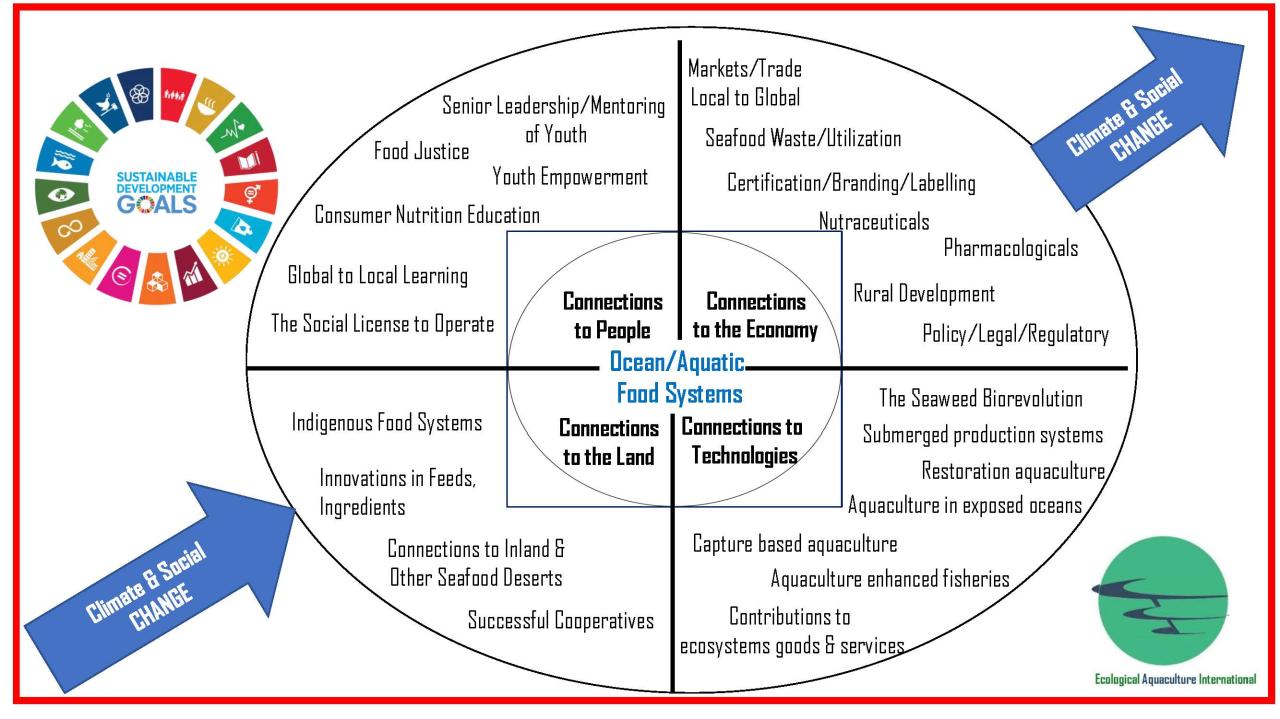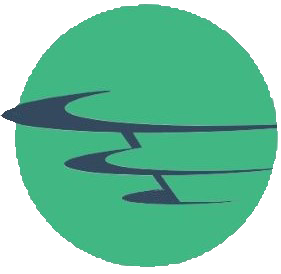FAO (2012) stated that “Fisheries and aquaculture interact with increasing intensity as fishers shift from fishing to aquaculture and by competing in the same markets with similar products. The need to integrate planning and management of the two sectors seems vital to their future development and sustainability.” Klinger et al. (2013) recognized that ocean food systems are increasingly “hybrid seafood systems” where fisheries and aquaculture products enter common marketplaces.
In modern markets substantial price and volume competition occur between fisheries and aquaculture products. Buyers at the top global seafood expos such as “Seafood North America” (Boston, USA) or “Seafood Expo” (Barcelona, Spain) engage widely in the “white fish” market.
Salmon is a red fish that has a separate market altogether.
If white fish buyers cannot meet market demands for cod or haddock from capture fisheries, they purchase tilapia or pangasius catfish (Pangasionodon hypophthalmus) from aquaculture. Little et al. (2012) called some of these unrecognized interactions in the EU the “white fish wars”.
This has been known for over 20 years, but there's been little change. Capture fisheries and aquaculture are managed separately with little/no communication in agencies or in applied academia about their current state-of-the-art, or their future.
At worst, both capture fisheries and aquaculture are regulated and managed by environmental scientists, marine/aquatic biologists or agriculture professionals who have little/no training or experiences in either. Many have never been on or worked a vessel or an aquaculture farm but think they know so much about both since they’ve "been on websites".
TYPOLOGIES OF OCEAN FOOD SYSTEMS
Capture Fisheries
Capture fisheries are the capture and harvest of wild aquatic organisms where no interventions are made to manage or otherwise influence captured organisms by containment, feeding, or applications of aquaculture techniques.
Enhancement Options for Capture Fisheries
Artificial reefs and fish aggregating devices (FADs) either aggregate or increase fish populations with impacts on overall production. Many impacts remain complex such that management decisions are difficult, as ocean structures can enhance fisheries in unexpected ways. This is important when considering options for ocean food systems integrated into or around new developments of offshore wind power (Costa-Pierce 2023b). For example, Claisse et al. (2014) found that oil/gas platforms off California had the highest secondary fish production per unit area of seafloor of any studied marine habitat by about an order of magnitude. Platforms provided a “substantial amount of complex hardscape…distributed throughout the water column”.
Aquaculture-Enhanced Fisheries
A capture fishery that is sustained wholly or in part by the introduction of aquaculture organisms at early, recruitment stages of a fishery using aquaculture hatchery/nursery systems to restock juveniles into the ocean to produce harvestable adults in the wild from a capture fishery is an aquaculture-enhanced fishery. Some US (Alaska) and Canadian Pacific salmon fisheries today are aquaculture-enhanced fisheries (Costa-Pierce 2023a) and the number is increasing. New hatcheries have been reported recently in the Russian Federation (Kamchatka), Korea, and Japan.
With accelerating climate change, restoration of salmon as a species in its Pacific southern range may now depend upon hatcheries. California (USA) wild salmon populations are collapsing. The commercial salmon fishery was closed in 2023, but salmon have not recovered despite expensive efforts to remove dams/barriers, restore habitats, and protect water flows. Thus, government policies are changing and aquaculture hatcheries are being expanded/modernized to “save” the salmon. In 2025, ~3.5 million fish were released into the Sacramento River. The California Fisheries Branch Chief said, “This significant shift in strategy speaks to CDFW’s (California Department of Fisheries & Wildlife) long-term commitment to boosting these important salmon populations.”
Capture-Based Aquaculture
A capture fishery that live harvests wild organisms at early stages in their life cycle and transports them to aquaculture systems for growout under confinement and management to harvestable mature adults is a capture-based aquaculture (Lovatelli and Holthus 2008). Capture-based aquaculture is not reported as a separate category in global summaries (Klinger et al., 2013) but was estimated 20 years ago to account for ~20% of the total quantity of food fish production worth ~US$1.7 billion (Ottolenghi et al. 2004).
Proto-Aquaculture
It is widely accepted that aquaculture arose multiple times in societies as an evolution from capturing and trapping fish, to holding and keeping fish, and to reproducing, growing, and domesticating fish (Costa-Pierce 2022; Edwards 2025).
There is much confusion on what is true aquaculture or what is “proto-aquaculture”. Proto-aquaculture” is the small amount of control over the life cycle of an aquatic species with little management or other interventions on aquatic production (Beveridge and Little 2022).
True Aquaculture
Aquaculture is where complete control of the life cycle species is achieved in captivity, with little/no interventions from the wild required. Think of cattle or chicken farming. The ancestors of all cattle today – the auroch – are extinct. Chickens are a “synthetic” species separate from any wild relatives. It can be argued that farmed salmon, trout, carps, tilapia, and shrimp are similarly “synthetic” species; for example, a "farmed type" tilapia is an Oreochromis spp., not a "wild type" Oreochromis niloticus.
“True” aquaculture is a closed aquaculture production network having little/no connection to the “wild” (Costa-Pierce et al. 2022). True aquaculture is closed cycles of farm production - hatcheries, regular stocking, feeding, disease and parasite control, and protection from predators.
Anderson (2002) defined the difference between fisheries and aquaculture based on the degree of property rights given to harvesters by management entities.
In true aquaculture, broodstock are selected from grow-out ponds. In some cases, after many generations there is a genetic "erosion", and a need to return to the wild types for replenishment of farmed stocks; but this is not large-scale wild harvesting. Rather, it is careful selection from the wild type, as was done by ICLARM/World Fish Center in the development of a “Genetically Improved Farmed Tilapia” (GIFT).
Observations
Dr. James Anderson, a World Bank fisheries economist (and University of Rhode Island Professor) had a great quote when writing about aquatic food systems (Anderson 2002). He considered a typical meeting of fisheries experts and said:
"They debate fisheries management and innovative solutions to the great open-access problems. When they break to eat dinner, it is likely to consist of salmon or shrimp. Yet they seem oblivious to the fact that the seafood they are consuming is farmed. They eat the future of fisheries, but they continue to discuss its past."
Expansion of blue, circular bioeconomies will require more comprehensive understanding and planning for ocean food systems. Acquisition of additional transdisciplinary knowledge will increase production and social-ecological benefits for blue economies. However, adoption of this philosophy of ocean/aquatic food systems will be disruptive as they require radically changed science, education, management, and development policies.
Complex, yes, but developing ocean/aquatic food systems policies and approaches have a greater potential to advance blue bioeconomies and livelihoods than maintaining/restoring capture fisheries or accelerating the development of aquaculture alone.

References
Anderson, J. 2002. Aquaculture and the future: why fisheries economists should care. Mar. Res. Econ. 17:133–151.
Beveridge, M. and D. Little. 2002. “The history of aquaculture in traditional societies,” in Ecological Aquaculture: The Evolution of the Blue Revolution, ed. B.A. Costa-Pierce (Oxford, U.K.: Blackwell), 3–29.
Claisse, J. et al. 2014. Oil platforms off California are among the most productive marine fish habitats globally. PNAS 28, 15462-15467. doi: 10.1073/pnas.1411477111
Costa-Pierce, B. 2022. The anthropology of aquaculture. Frontiers in Sustainable Food Systems doi:10.3389/fsufs.2022.843743
Costa-Pierce, B. et al. 2022. Ocean/aquatic food systems: Interactions with ecosystems, fisheries, aquaculture, and people. Frontiers in Sustainable Food Systems https://doi:10.3389/fsufs.2022.1021801
Costa-Pierce, B. 2023a. Ocean food systems and hybrid seafood production: Transdisciplinary case studies of cod, eels, salmon and lobster. Sustainable Development Research 5 (1): 31-43. https://doi.org/10.30560/sdr.v5n1p31
Costa-Pierce, B. 2023b. A social-ecological approach to the development of integrated offshore food/wind energy systems. Invited Speaker, University of Rhode Island, Narragansett, RI, USA
Edwards, P. 2025. Co-evolution of fish and rice farming by Austroasiatic communities in the Neolithic Era and early documentation of aquaculture in China. Front. Aquac. 3:1437833. doi: 10.3389/faquc.2024.1437833
FAO. 2012. The State of World Fisheries and Aquaculture. Rome, Italy: FAO.
Klinger, D. et al. 2013. Moving beyond the fished or farmed dichotomy. Mar. Pol. 38: 369–374.
Little, D. et al. 2012. Whitefish wars: Pangasius, politics and consumer confusion in Europe. Marine Pol., 36, 738-745.
Lovatelli, A. and P.F. Holthus. 2008. Capture-based aquaculture, Global overview. FAO Fisheries Technical Paper. No. 508. Rome, Italy: FAO.
Ottolenghi, F. et al. 2004. Capture-based Aquaculture. The Fattening of Eels, Groupers, Tunas and Yellowtails. Rome, Italy: FAO.


